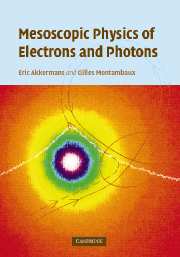Book contents
- Frontmatter
- Contents
- Preface
- How to use this book
- 1 Introduction: mesoscopic physics
- 2 Wave equations in random media
- 3 Perturbation theory
- 4 Probability of quantum diffusion
- 5 Properties of the diffusion equation
- 6 Dephasing
- 7 Electronic transport
- 8 Coherent backscattering of light
- 9 Diffusing wave spectroscopy
- 10 Spectral properties of disordered metals
- 11 Universal conductance fluctuations
- 12 Correlations of speckle patterns
- 13 Interactions and diffusion
- 14 Orbital magnetism and persistent currents
- 15 Formulary
- References
- Index
8 - Coherent backscattering of light
Published online by Cambridge University Press: 06 January 2010
- Frontmatter
- Contents
- Preface
- How to use this book
- 1 Introduction: mesoscopic physics
- 2 Wave equations in random media
- 3 Perturbation theory
- 4 Probability of quantum diffusion
- 5 Properties of the diffusion equation
- 6 Dephasing
- 7 Electronic transport
- 8 Coherent backscattering of light
- 9 Diffusing wave spectroscopy
- 10 Spectral properties of disordered metals
- 11 Universal conductance fluctuations
- 12 Correlations of speckle patterns
- 13 Interactions and diffusion
- 14 Orbital magnetism and persistent currents
- 15 Formulary
- References
- Index
Summary
Introduction
Phase coherence is at the basis of the interference effects which lead to weak localization in electronics. This phase coherence also has important consequences in optics. Moreover, using an incident laser beam, it is possible in optics to study the angular behavior of both transmitted and reflected waves. This is difficult in electronic devices, where electrons are injected and collected from reservoirs and do not have an accessible angular structure. In this chapter, we study the intensity of the light reflected by a diffusive medium and we show that it has an angular structure that is due to the coherent effects associated with the Cooperon. We also show that it is possible to single out and analyze the contribution of multiple scattering paths as a function of their length. This leads to a kind of “spectroscopy” of diffusive trajectories.
The issue of wave scattering in disordered media has a long history. At the turn of the twentieth century, a purely classical approach to the description of radiative transfer of electromagnetic waves through the atmosphere, based on the Boltzmann equation, had already been proposed by Schuster [206]. This problem was subsequently extended to include the related domains of turbulent media, meteorology and liquids. It was only during the 1980s, however, that the possibility of phase coherent effects in the multiple scattering of waves in random media was raised. The interest surrounding this question is certainly related to new developments in similar questions in the quantum theory of scattering [207–209]. Asystematic description of coherent effects emphasizing the role of the Cooperon was initially proposed in references [210] and [211].
- Type
- Chapter
- Information
- Mesoscopic Physics of Electrons and Photons , pp. 320 - 353Publisher: Cambridge University PressPrint publication year: 2007

